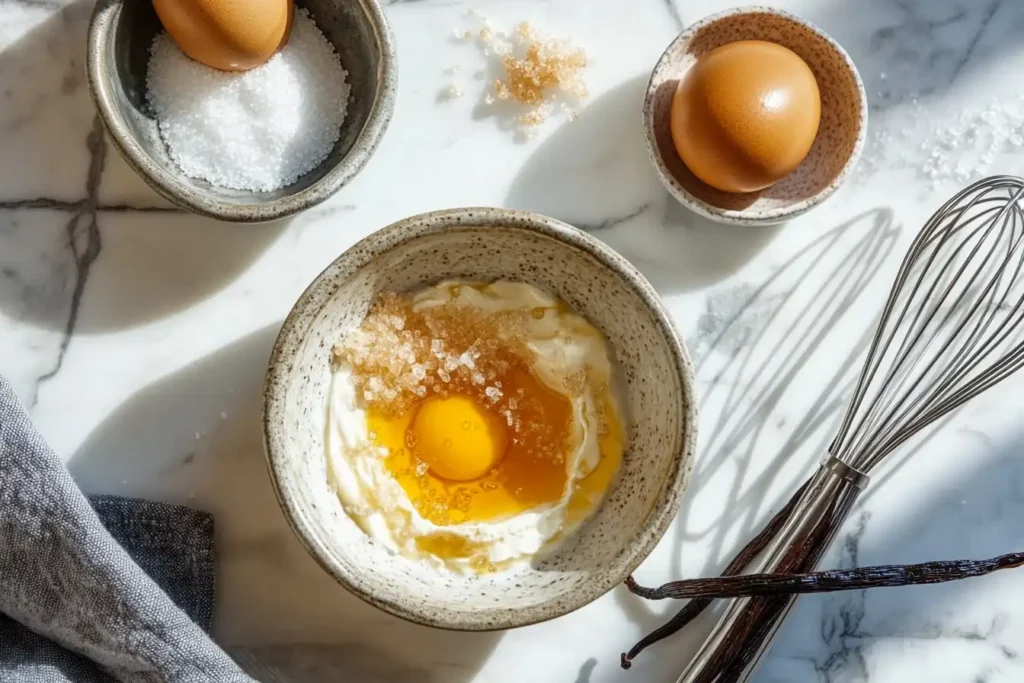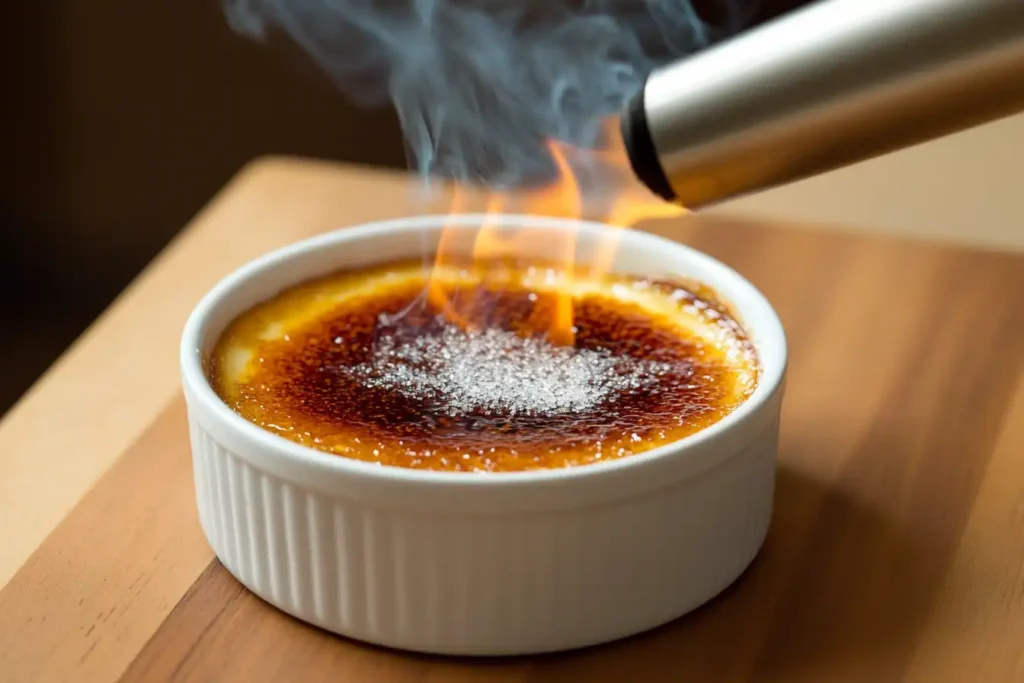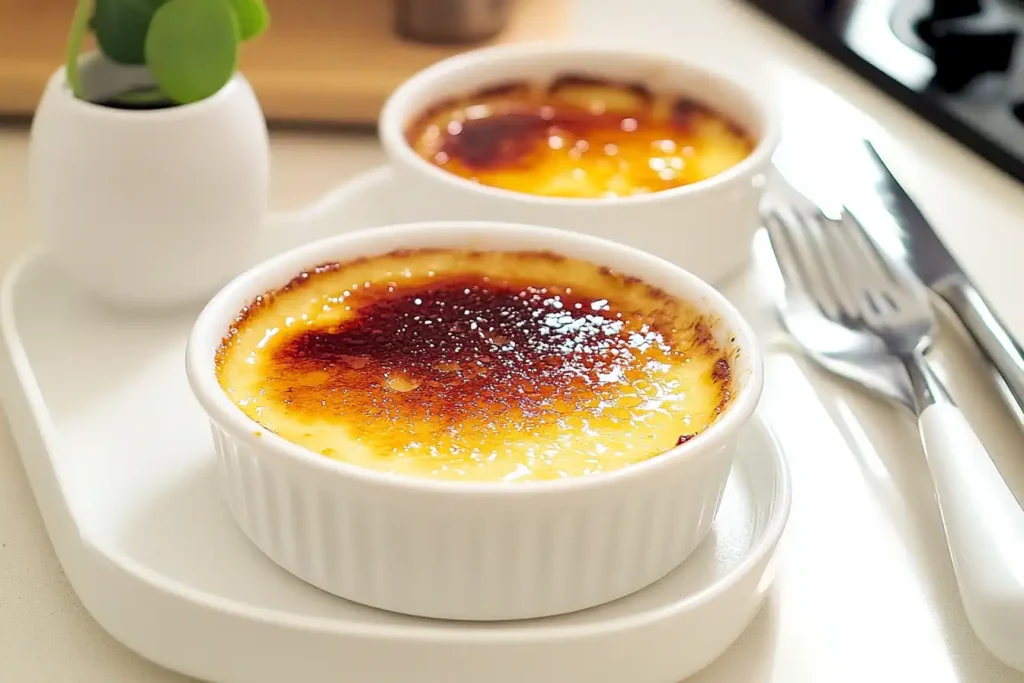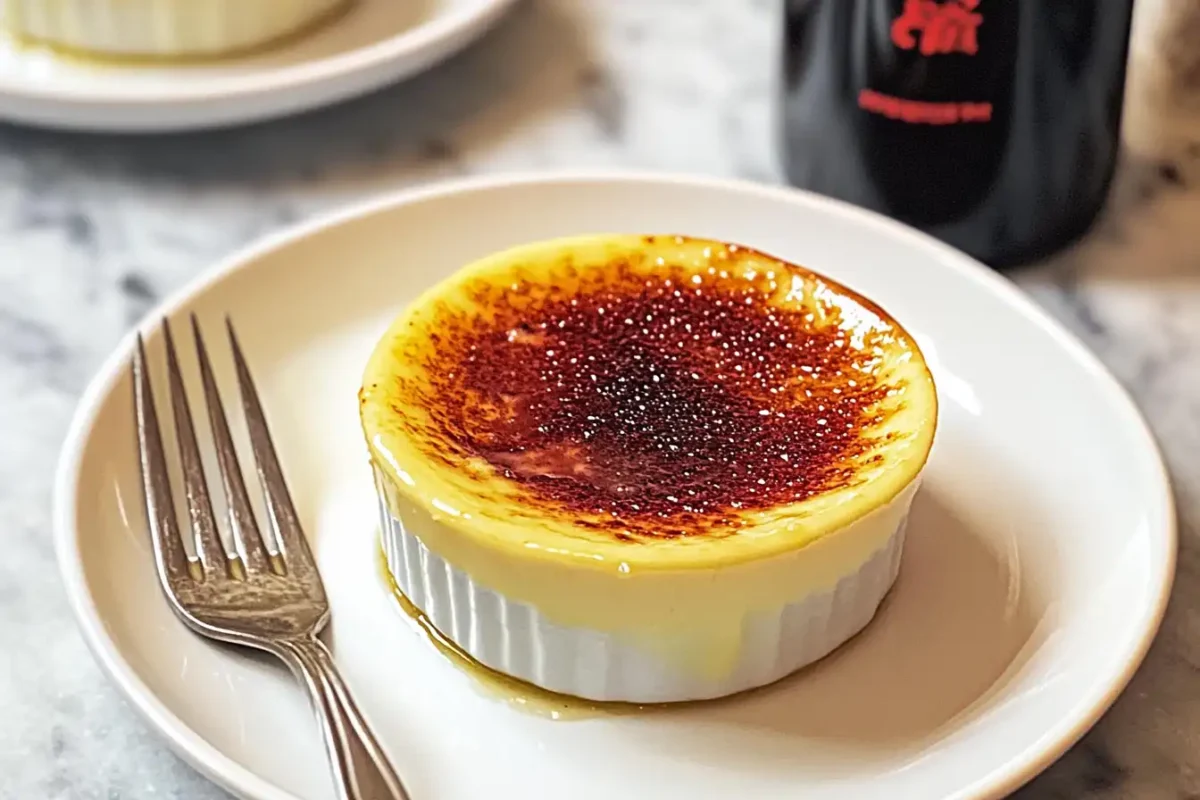What Is Crème Brûlée Made Of?
When you think of indulgence, crème brûlée undoubtedly comes to mind. This iconic dessert combines the velvety smoothness of custard with a crunchy sugar crust, creating a harmonious texture that’s hard to resist. But what exactly goes into making this classic treat? Crème brûlée is made of simple ingredients like cream, egg yolks, sugar, and vanilla – but its charm lies in how these elements come together.
Definition and Origin of Crème Brûlée
Crème brûlée, meaning “burnt cream” in French, is believed to have originated in the late 17th century. It is a culinary gem from France, though similar desserts can be traced to England and Spain as well. Its global popularity grew as chefs refined the recipe, elevating its creamy texture and caramelized top.
Historical Background
Though the origins of crème brûlée are debated, its first recorded recipe appeared in François Massialot’s 1691 cookbook. This dessert soon became a staple in French cuisine, celebrated for its simplicity and elegance. Over time, chefs around the world added their personal flair, cementing its status as a favorite on dessert menus.
Traditional Ingredients
Crème brûlée’s allure comes from its simplicity. With just four main ingredients – cream, sugar, egg yolks, and vanilla – this dessert proves that a few high-quality elements can create something extraordinary.
The Classic Components of Crème Brûlée
What truly makes crème brûlée irresistible is its perfect balance of flavor and texture. Let’s break down its essential components:
Custard Base
The creamy base of crème brûlée is a custard made with a rich mixture of cream, egg yolks, and sugar. Properly preparing the custard is the key to achieving that silky smooth texture.
Cream
The cream is the foundation of the custard, giving it a luxurious texture. Bakers typically use heavy cream for its high fat content, which adds to the dessert’s signature richness.
Egg Yolks
Egg yolks are the unsung heroes of the custard. They add structure and richness while helping to bind the ingredients together.
Caramelized Sugar Topping
The famous caramelized sugar crust completes every crème brûlée. You evenly spread a thin layer of sugar over the custard and melt it to create a crunchy top layer. Breaking through this crust is one of the most satisfying aspects of enjoying crème brûlée!
Detailed Breakdown of Ingredients
Cream: The Foundation of the Custard

Cream is the star ingredient that forms the backbone of crème brûlée’s luscious custard. Its rich texture and high fat content are what give the dessert its creamy and indulgent consistency. Without cream, the custard would lack the silky smoothness that makes this dish unforgettable.
Types of Cream Used
Heavy cream, also known as whipping cream, is the most common choice for crème brûlée. Its high-fat content, typically around 36%, provides the velvety texture this dessert demands. Some variations use a combination of heavy cream and milk to slightly lighten the custard. However, full cream remains the gold standard for achieving the desired richness.
Role of Cream in Texture and Flavor
Cream not only determines the custard’s texture but also subtly influences its flavor. Its neutral profile allows the sweetness of sugar and the depth of vanilla to shine through. Moreover, cream contributes to the luxurious mouthfeel that sets crème brûlée apart from other custard-based desserts.
Egg Yolks: Providing Richness and Structure
Egg yolks are another critical element in the making of crème brûlée. They provide the custard with a firm yet tender structure, ensuring it holds its shape while retaining a soft, melt-in-your-mouth quality.
Importance of Egg Yolks in Custard
The proteins in egg yolks thicken the custard as it cooks, giving it a smooth and cohesive texture. Without yolks, the custard would lack the stability required to set properly. Additionally, yolks add a natural yellow hue and a rich, creamy taste that complements the cream beautifully.
Selecting Quality Eggs
Choosing fresh, high-quality eggs is vital. Opt for eggs with vibrant, deep-yellow yolks, as they often indicate superior quality and flavor. Free-range or organic eggs can elevate the custard’s taste and texture, making them a worthwhile investment for this delicate dessert.
Sugar: Sweetness and Caramelization
Sugar serves two essential roles in crème brûlée: it sweetens the custard base and creates the iconic caramelized topping. Its versatility transforms the dessert from simple to extraordinary.
Sugar in the Custard Base
In the custard, sugar balances the richness of the cream and egg yolks. It dissolves easily during the mixing process, ensuring a smooth and consistent texture. The level of sweetness can be adjusted according to personal preference, but it’s crucial not to overpower the other flavors.
Creating the Caramelized Topping
The thin sugar layer on top of crème brûlée is what makes this dessert visually stunning and texturally unique. After the custard sets, granulated sugar is evenly sprinkled and then caramelized using a kitchen torch. The result? A golden-brown crust that cracks delightfully with every spoonful. If a torch isn’t available, broiling the dessert is a handy alternative.
Vanilla: Enhancing the Flavor Profile
| Nutrient | Amount (per 100g) |
|---|---|
| Calories | 250 kcal |
| Protein | 3.5 g |
| Carbohydrates | 25 g |
| Sugars | 22 g |
| Fat | 16 g |
| Saturated Fat | 10 g |
| Cholesterol | 120 mg |
| Sodium | 45 mg |
Vanilla is the signature flavor in crème brûlée, lending a delicate aroma and depth that elevates the custard’s simplicity. Whether using fresh vanilla beans or extract, this ingredient is essential for achieving the dessert’s classic taste.
Using Vanilla Beans vs. Extract
Vanilla beans provide the most authentic and rich flavor, making them a popular choice for creating truly exceptional crème brûlée. Moreover, the seeds scraped from the pod not only infuse the custard with a natural sweetness but also add a delightful aromatic depth that elevates the overall flavor. Additionally, the use of real vanilla beans enhances the dessert’s visual appeal by speckling the custard with tiny black seeds, showcasing its handcrafted quality. By incorporating vanilla beans, you bring an unparalleled level of sophistication and flavor to this classic dessert. However, high-quality vanilla extract is a convenient alternative that still delivers excellent results. For an even richer flavor, some recipes combine both beans and extract.
Infusing Vanilla into the Custard
To maximize the vanilla’s impact, it’s infused into the cream before blending with other ingredients. Heating the cream with a split vanilla bean allows the flavors to meld beautifully. If using extract, it’s best to add it after heating to preserve its delicate aroma.
Preparation Techniques
Crafting the Perfect Custard
Creating the custard for crème brûlée is both an art and a science. Every step in making crème brûlée requires precision, as even the smallest misstep can affect the final result’s smooth, creamy, and indulgent texture. Furthermore, from combining the ingredients to achieving the perfect consistency, paying close attention to detail at every stage is absolutely crucial. Additionally, carefully measuring, mixing, and handling the custard ensures that the flavors meld harmoniously while the texture remains velvety and luxurious. By dedicating time and focus to each step, you can consistently create a dessert that delights both the eyes and the taste buds.
Mixing Ingredients
Start by whisking egg yolks and sugar together until the mixture turns pale and creamy. This process, known as emulsification, ensures the sugar dissolves completely, creating a uniform texture. Gradually add the warmed cream, incorporating it slowly to avoid cooking the eggs. If using vanilla beans, infuse them into the cream during the warming stage for maximum flavor.
Achieving the Right Consistency
Strain the custard mixture through a fine sieve before pouring it into ramekins. This step removes any lumps or bubbles, resulting in a silky-smooth custard. The ideal consistency is slightly thick yet still pourable, ensuring it sets perfectly in the oven.
Baking Methods for Optimal Results
The baking process plays a pivotal role in determining the smooth, creamy texture that makes crème brûlée so irresistible. In addition, following proper techniques is crucial to ensure that the custard cooks evenly, preventing unwanted curdling or overcooking. By mastering the correct baking methods, you not only achieve the dessert’s signature creaminess but also enhance its overall consistency and flavor. Furthermore, paying close attention during baking guarantees that the custard sets perfectly, providing the ideal foundation for the caramelized sugar topping.
Water Bath Technique
To prevent the custard from curdling or cracking, bake the ramekins in a water bath. Place the ramekins in a deep baking dish and fill the dish with hot water until it reaches halfway up the sides of the ramekins. This method provides gentle, even heat, protecting the custard from direct oven heat.
Determining Doneness
Knowing when the custard is done is essential. Bake it at 325°F (160°C) until the edges are set, but the center still has a slight jiggle when gently shaken. Overbaking can lead to a grainy texture, so keep a close eye during the final minutes.
Caramelizing the Sugar Topping

The caramelized sugar topping is what sets crème brûlée apart. It’s a sensory delight that contrasts beautifully with the creamy custard below. Crafting the perfect topping requires both technique and precision.
Using a Kitchen Torch
A kitchen torch remains the preferred tool for caramelizing the sugar on crème brûlée, as it offers precision and control. After evenly sprinkling a thin layer of granulated sugar over the chilled custard, carefully use the torch to melt the sugar into a smooth, glossy layer. Moreover, it’s important to move the flame in a steady, circular motion to prevent uneven spots or burning, while also ensuring the crust develops a consistent, golden-brown color. This method not only creates the iconic caramelized topping but also enhances the dessert’s visual appeal and satisfying crunch.
Alternative Methods
If a torch isn’t available, the caramelization process can be achieved using an oven broiler. Place the ramekins on the top rack and watch closely as the sugar melts and browns. Although slightly less precise, this method still delivers a delightful crunchy topping.
Variations and Enhancements
Flavor Variations of Crème Brûlée
One of the most delightful aspects of crème brûlée is its versatility. While the classic vanilla flavor is timeless, this dessert can be customized with creative additions to suit different tastes. From rich chocolate to fresh fruit, the possibilities are endless.
Chocolate Crème Brûlée
For chocolate lovers, adding melted chocolate to the custard base transforms the dessert into a decadent masterpiece. Simply mix high-quality dark or milk chocolate into the warmed cream before combining it with the egg yolks and sugar. The result is a luscious, silky custard with a deep cocoa flavor that pairs beautifully with the caramelized sugar topping.
Fruit-Infused Crème Brûlée
Fruit-infused variations offer a refreshing twist on the classic recipe. Popular options include using puréed raspberries, orange zest, or passion fruit juice, which can be mixed directly into the custard. Alternatively, layer fresh fruit at the bottom of the ramekins before adding the custard. The natural sweetness and tang of the fruit provide a delightful contrast to the creamy texture.
Dietary Adaptations
You can tailor crème brûlée to accommodate dietary preferences or restrictions, making it accessible to a broader audience.Whether avoiding dairy or reducing sugar, there are excellent substitutions that maintain the dessert’s quality and flavor.
Dairy-Free Alternatives
For those seeking a dairy-free option, coconut cream, almond milk, or cashew cream can replace heavy cream in the custard. Coconut cream, in particular, works well due to its similar richness and creamy consistency. To enhance the flavor, pair it with complementary ingredients like lime or vanilla.
Sugar Substitutes
Reducing sugar intake doesn’t mean missing out on crème brûlée. Sweeteners like stevia, erythritol, or coconut sugar can be used in place of granulated sugar. While stevia and erythritol offer low-calorie options, coconut sugar adds a caramel-like flavor that complements the custard beautifully. However, achieving the perfect caramelized topping may require experimenting with these alternatives.
Serving and Pairing Suggestions
Presentation Tips for Crème Brûlée
Crème brûlée is as much about its stunning presentation as it is about its incredible taste. In fact, the way you serve this dessert can dramatically enhance its overall appeal and create a memorable dining experience. Additionally, an elegant presentation not only highlights the craftsmanship behind the dish but also ensures that crème brûlée becomes the standout centerpiece of any meal. By paying attention to details in how it’s served, you can elevate its charm and leave a lasting impression on your guests. A thoughtful presentation not only enhances the visual experience but also reflects the care and attention given to its preparation.

Choosing the Right Ramekins
Selecting the right ramekins is an essential step, as it significantly impacts the evenness of cooking and enhances the elegant presentation of crème brûlée. Furthermore, traditional ramekins, known for being shallow and wide, offer the perfect ratio of custard to caramelized sugar, ensuring each bite delivers a harmonious balance of textures and flavors. By choosing the proper ramekins, you not only guarantee consistent cooking but also elevate the dessert’s visual appeal, making it both delicious and aesthetically pleasing.Additionally, ceramic ramekins are a popular choice because they retain heat effectively, which helps the custard cook evenly, and they also offer a timeless, classic aesthetic that elevates the dish. However, if you want to add a modern twist to your presentation, you can experiment with ramekins in unique shapes, vibrant colors, or textured designs to perfectly complement your table setting and delight your guests.
Garnishing Ideas
While the caramelized sugar topping is already a showstopper, adding garnishes can further enhance the dessert’s appeal. Fresh berries, such as raspberries or blueberries, provide a pop of color and a tangy contrast to the sweet custard. A sprig of mint adds a touch of freshness, while a dusting of powdered sugar or edible flowers gives the dish an elegant finish.
Ideal Beverage Pairings
Pairing crème brûlée with the right beverage can elevate the dining experience. Whether you prefer a warm drink or something more indulgent, the right pairing will complement the dessert’s creamy richness and sugary topping.
Coffee and Tea Options
Rich, robust coffee is an excellent companion to crème brûlée, as its bold flavors balance the dessert’s sweetness. Espresso or French press coffee works particularly well. If tea is your preference, opt for a strong black tea, like Earl Grey, or a fragrant herbal tea, such as chamomile, to harmonize with the custard’s delicate vanilla notes.
Frequently Asked Questions About Crème Brûlée
FAQs About Crème Brûlée
Can I Make Crème Brûlée Without a Torch?
Yes, you can make crème brûlée without a torch! Instead, use your oven’s broiler. Place the ramekins on the top rack and keep a close watch as the sugar melts and caramelizes. It may not achieve the same precision as a torch, but it still produces a delightful crunchy topping.
How Long Does Crème Brûlée Last in the Refrigerator?
Crème brûlée can be stored in the refrigerator for up to 3 days. Cover the ramekins tightly with plastic wrap to prevent odors from affecting the custard. Wait to caramelize the sugar topping until just before serving for the best texture.
Why Is My Custard Not Setting Properly?
If your custard isn’t setting, it’s likely underbaked or the egg-to-cream ratio is off. Ensure you bake it in a water bath and check that the oven temperature is accurate. The edges should be set while the center retains a slight jiggle.
Can I Use Milk Instead of Cream?
Milk can be used as a substitute for cream, but the custard will be less rich and creamy. For a better compromise, consider using a mixture of whole milk and a small amount of heavy cream to maintain some of the dessert’s signature texture.
How Do I Achieve a Smooth Custard Texture?
To achieve a smooth custard, always strain the mixture through a fine mesh sieve before pouring it into ramekins. This step removes any lumps or bits of cooked egg, resulting in a velvety texture. Also, avoid overmixing, which can introduce air bubbles.
What Is the Difference Between Crème Brûlée and Crème Caramel?
While both desserts rely on a custard base, crème brûlée offers a crunchy caramelized sugar topping, whereas crème caramel presents a soft caramel layer on top and flips upside down for serving.Crème brûlée is richer, while crème caramel tends to be lighter.
Mastering the Art of Crème Brûlée at Home
Recap of Key Points
Many people love crème brûlée because its simple yet elegant ingredients—cream, egg yolks, sugar, and vanilla—create a timeless dessert.Not only does its creamy custard base create a luxurious texture, but the caramelized sugar topping also adds a satisfying crunch that perfectly balances the dessert. To truly master this classic dish, it is essential to understand its ingredients, explore the various preparation techniques, and experiment with creative variations, all of which contribute to its enduring charm and versatility. Furthermore, by refining your methods and paying attention to details, you can elevate this already exquisite dessert to new levels of perfection.
Encouragement to Experiment and Enjoy
Don’t be afraid to experiment with flavors and adapt the recipe to your preferences. Whether you stick to the traditional version or explore new twists, making crème brûlée at home is a rewarding experience. With practice and care, you can create a dessert that’s as impressive as it is delicious.
This concludes the journey into crème brûlée. Now it’s your turn to grab those ramekins and create this delectable treat!
For more inspiration and creative ideas, don’t miss our latest article:”Crème Brûlée vs Custard“. It’s packed with fresh recipes and tips to make your cooking experience even more enjoyable!”
For more inspiration and creative ideas, don’t miss our latest article:”Crab Brulee Recipe“. It’s packed with fresh recipes and tips to make your cooking experience even more enjoyable!”

